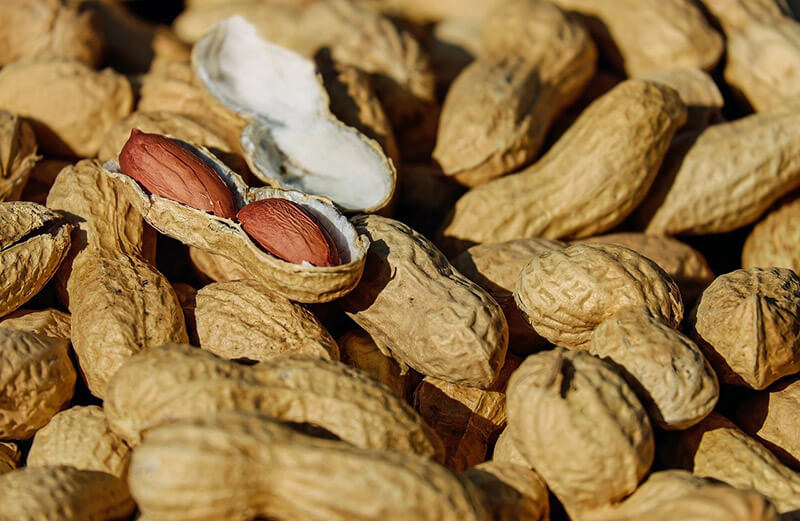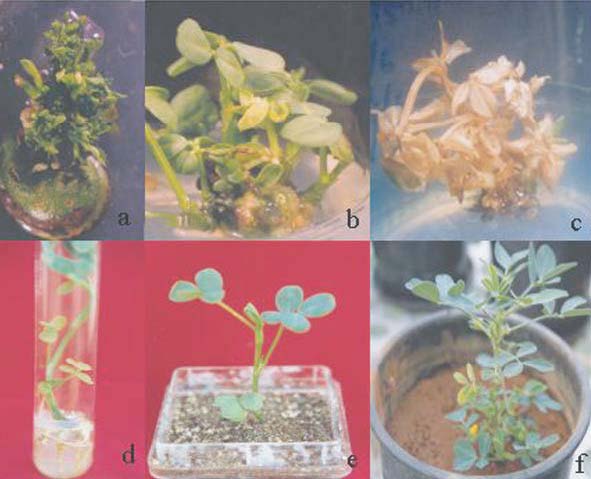Arachis hypogaea L., also known as peanut, It is a kind of nut that is rich in oil and protein and widely edible in the world. as an annual herbaceous plant of the leguminous family. Arachis hypogaea L. contain 25%-35% of protein. Its protein biological valence is 58, protein biological potency is 1.7. Its nutritional value is second only to soy protein in all plant protein. Arachis hypogaea L. is also rich in vitamins, minerals, amino acids, and unsaturated fatty acids.
In order to improve the nutritional value of peanuts, simplify the cultivation process, In recent years, research on genetically modified Arachis hypogaea L. has become a hot field. We can help you develop peanuts with strong disease resistance, insect resistance, herbicide resistance, salt tolerance, and cold tolerance, as well as longer storage period.

Lifeasible provides one-stop services, covering all steps including experimental design, vector construction, plasmid transformation, positive transplant screening and characterization of transgenic Arachis hypogaea L. We offer Arachis hypogaea L. transformation using various genetic engineering technologies as follows:
Through the quantitative overexpression of genes related to unsaturated fatty acid,catechin, resveratrol and other chemical components in Arachis hypogaea L., the production of specific compounds can be increased. We could help you overexpress many genes including AhFAD2 that regulates the accumulation of oleic acid in peanut seeds, gene AhBS1 that related to the size of peanut seeds, related genes PAP1, CDS1/2, MGD, DGD1 and SQD2 which regulate cold tolerance, and many other genes related to important traits of Arachis hypogaea L.
RNAi technology is widely used in the field of gene editing, it refers to the phenomenon of highly conserved, induced by double-stranded RNA (dsRNA), homologous mRNA high-efficiency and specific degradation in the evolutionary process. Through RNAi technology, the silencing of multiple genes in Arachis hypogaea L. can be mediated.
Virus induced gene silencing (VIGS) means that after viruses carrying target gene fragments infect plants, they can induce plant endogenous gene silencing and cause phenotypic changes, and then study the function of target genes based on phenotypic variation. The VIGS technology is a method of transient transformation and underlying molecular basis may be post-transcriptional gene silencing. Silencing and functional analysis of target genes in Arachis hypogaea L. through VIGS can help you save time and achieve valuable information for gene functional analysis. With wealth of experience in VIGS, the scientists in Lifeasible provides you customized protocol for VIGS in Arachis hypogaea L. We could achieve the transformation for Arachis hypogaea L. with different genetic backgrounds.
The discovery of the CRISPR/Cas9 system provides us with a very powerful and convenient gene editing tool. By using CRISPR technology, we can knockout Arachis hypogaea L.’s genes in different ways, including frameshift mutations, multiple deletion of fragments, knockout of non-coding genes, knockout of multiple copies of genes, etc.
CRISPR system has strong scalability, and this scalability can be used to develop more useful gene editing tools. we have developed many methods that can improve gene knock-in efficiency and achieve precise editing of the Arachis hypogaea L. genome. For the gene knock-in process, most of CRISPR gene knock-in is done through HDR. However, NHEJ and HDR will occur at the same time due to DNA breaks. Therefore, we have developed different methods to increase the probability of HDR, thereby improving the efficiency of gene knock-in.
CRISPR Single base editing technology is a hot area of life science research today. As a company that has been cultivating gene editing technology for decades, Lifeasible could help you achieve the conversion from C to T or A to G in Arachis hypogaea L. using CBE and ABE, both of which rely on the DNA positioning capabilities of the CRISPR/Cas9 system. During single base editing, the C base deaminase or A base deaminase is located at a specific position in the genome, and it catalyzes the deamination reaction of C or A at a specific position and turns it into U or I. Then it is treated as T or G in the process of DNA replication, realizing the conversion from C to T or A to G.
As a variant of CAS protein after domain inactivation, dCAS9 still retains the ability to recognize and bind to specific DNA sequences, so it can derive many important functions. One of them is CRISPR Interference. There are many ways to participate in the inhibition of gene expression. For the inhibition of Arachis hypogaea L. genes, we can provide a variety of solutions, including dCas9 binding to targeted DNA and realizing Inhibition of gene transcription through steric hindrance. In addition, gene knockdown can also be achieved by recruiting a fusion protein to the start site of gene transcription.
CRISPRa technology uses the powerful capabilities of Cas9 and sgRNA to fuse or recruit multiple proteins to enhance gene transcription. For Arachis hypogaea L. genes, we provide VPR technology, SAM technology and Suntag technology to allow the CRISPR system to carry more activation element and achieve a stronger activation effect after synergistic amplification.
The study of gene function has always been the core subject of biological research. The earliest genetic screening system established through forward genetics is very inefficient and has a huge workload. However, the reverse genetic screening system based on CRISPR technology can complete very low-cost mutation library construction work. The gene mutation library construction technology we provide for Arachis hypogaea L. including gene knockout library construction, gene knockdown library construction, and gene activation library construction. Moreover, single-cell sequencing is also available for mutation screening.
DNA-free gene editing technology has received extensive attention from the industry in recent years. We provide DNA free Arachis hypogaea L. genome editing services, including transient expression of CRISPR/Cas9 plasmid DNA, in vitro transcription of CRISPR/Cas9, and pre-assembled ribonucleic acid composed of purified Cas9 protein and sgRNAs complex. These technologies can avoid the integration of foreign DNA and genome, and reduce off-target effects. In addition, compared with traditional techniques, these techniques can avoid the use of hybridization or backcrossing to isolate CRISPR/Cas9 chimeras, so they are cheaper and have shorter experimental cycles.
Genetic Transformation Process for Arachis hypogaea L.
Plant gene transformation technology is a basic technology for studying plant gene functions and obtaining excellent plant traits. So far, the most advanced and widely used method for the development of genetically modified Arachis hypogaea L. is Agrobacterium-mediated t cotyledonary nodes dip method (Figure 1).
 Figure 1. Agrobacterium mediated transformation of Arachis hypogaea L.through cotyledonary nodes dip method, (a) CN explants showing multiple bud induction after three weeks on SIM containing 175 mg/L kanamycin, (b) Cultures with complete green multiple shoots after six weeks on SIM containing 175 mg/L kanamycin, (c) Completely bleached control cultures on SIM containing 175 mg/L kanamycin, (d) Profusely rooted shoot on RIM, (e) Hardening of plant in soil, (f) Acclimatization of plant in greenhouse conditions. (Sun S, et al. 2015)
Figure 1. Agrobacterium mediated transformation of Arachis hypogaea L.through cotyledonary nodes dip method, (a) CN explants showing multiple bud induction after three weeks on SIM containing 175 mg/L kanamycin, (b) Cultures with complete green multiple shoots after six weeks on SIM containing 175 mg/L kanamycin, (c) Completely bleached control cultures on SIM containing 175 mg/L kanamycin, (d) Profusely rooted shoot on RIM, (e) Hardening of plant in soil, (f) Acclimatization of plant in greenhouse conditions. (Sun S, et al. 2015)
Lifeasible offers our customers with professional one-stop services including experimental design, vector construction, plasmid transformation, positive transplant screening and testing, our experts have obtained comprehensive knowledge and years of experience to solve technical problems and challenges in Arachis hypogaea L. transformation., Our services guarantee the success of your project based on customized solution. For more information or any inquiry requirements, please contact Lifeasible.
Reference
Lifeasible has established a one-stop service platform for plants. In addition to obtaining customized solutions for plant genetic engineering, customers can also conduct follow-up analysis and research on plants through our analysis platform. The analytical services we provide include but are not limited to the following:
STU-CRISPR System Improves Plant Genome Editing Efficiency
April 19, 2024
Application of Exosomes in Facial Beauty
April 12, 2024